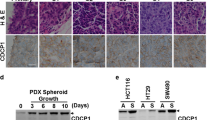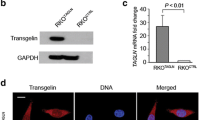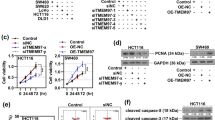Abstract
Increased expression and/or activity of c-Met, the receptor protein tyrosine kinase for hepatocyte growth factor/scatter factor, occurs commonly during colon tumor progression. To examine potential roles for c-Met in promoting metastasis, we compared the colon tumor cell line KM12C with low metastatic potential to the isogenic variants KM12L4 and KM12SM with high metastatic potential. KM12C cells express c-Met with low levels of tyrosine phosphorylation in the absence of HGF. The high metastatic cells express a c-Met that is constitutively tyrosine phosphorylated, they have increased colony formation, and are minimally responsive to HGF relative to the parental cells. Tyrosine-phosphorylated β-catenin was constitutively associated with c-Met in the more metastatic cells, but was inducible only after HGF addition in the less metastatic cells. Functions mediated by β-catenin, including cell–cell adhesion and migration, and activation of the tcf (T-cell factor) family of transcription factors, were also elevated in the more metastatic KM12SM and L4 cells. Furthermore, analysis of the known tcf transcriptional target genes, cyclin D1, c-Myc, and uPAR, demonstrated increased expression in the high metastatic cells, correlating with the levels of tcf activity. Collectively, these results suggest that endogenous activation of c-Met in highly metastatic KM12SM CRC cells results in increased survival and growth under anchorage independent conditions, increased in vitro migration, and elevated levels of tcf target genes. Thus, β-catenin association with activated c-Met may contribute to a more aggressive liver metastatic phenotype of these cells.
Similar content being viewed by others
References
Michalopoulos GK, DeFrances MC. Liver regeneration. Science 1997; 276: 60–6.
Maggiora P, Gambarotta G, Olivero M et al. Control of invasive growth by the HGF receptor family. J Cell Physiol 1997; 173: 183–6.
Weidner KM, Behrens J, Vandekerckhove J et al. Scatter factor: Molecular characteristics and effect on the invasiveness of epithelial cells. J Cell Biol 1990; 111: 2097–108.
Di Renzo MF, Olivero M, Giacomini A et al. Overexpression and amplification of the met/HGF receptor gene during the progression of colorectal cancer. Clin Cancer Res 1995; 1: 147–54.
Hasegawa Y, Yamamoto M, Maeda S et al. Hepatocyte growth factor and its receptor/c-Met regulate both cell growth and invasion of human pancreatic cancer. Int J Oncol 1995; 7: 877–81.
Rusciano D, Lorenzoni P, Burger MM. Expression of constitutively activated hepatocyte growth factor/scatter factor receptor (c-met) in B16 melanoma cells selected for enhanced liver colonization. Oncogene 1995; 11: 1979–87.
Ferracini R, Di Renzo MF, Scotlandi K et al. The Met/HGF receptor is over-expressed in human osteosarcomas and is activated by either a paracrine or an autocrine circuit. Oncogene 1995; 10: 739–49.
Matsumoto K, Nakamura T. HGF-c-Met receptor pathway in tumor invasion-metastasis and potential cancer treatment with NK4. In Jiang WG, Matsumoto K, Nakamura T (eds): Growth Factors and Their Receptors in Cancer Metastasis. Dordrecht, The Netherlands: Kluwer Academic Publishers 2001; 241–76.
Di Renzo MF, Olivero M, Martone T et al. Somatic mutations of the MET oncogene are selected during metastatic spread of human HNSC carcinomas. Oncogene 2000; 19: 1547–55.
Ebert M, Yokoyama M, Friess H et al. Coexpression of the c-met proto-oncogene and hepatocyte growth factor in human pancreatic cancer. Cancer Res 1994; 54: 5775–8.
Mondino A, Giordano S, Comoglio PM. Defective posttranslational processing activates the tyrosine kinase encoded by the MET protooncogene (hepatocyte growth factor receptor). Mol Cell Biol 1991; 11: 6084–92.
Olivero M, Valente G, Bardelli A et al. Novel mutation in the ATPbinding site of theMET oncogene tyrosine kinase in a HPRCC family. Int J Cancer 1999; 82: 640–3.
Park M, Dean M, Cooper CS et al. Mechanism of met oncogene activation. Cell 1986; 45: 895–904.
Park WS, Dong SM, Kim SY et al. Somatic mutations in the kinase domain of the Met/hepatocyte growth factor receptor gene in childhood hepatocellular carcinomas. Cancer Res 1999; 59: 307–10.
Rahimi N, Tremblay E, McAdam L et al. Identification of a hepatocyte growth factor autocrine loop in a murine mammary carcinoma. Cell Growth Differ 1996; 7: 263–70.
Schmidt L, Duh FM, Chen F et al. Germline and somatic mutations in the tyrosine kinase domain of the MET proto-oncogene in papillary renal carcinomas. Nat Genet 1997; 16: 68–73.
Schmidt L, Junker K, Weirich G et al. Two North American families with hereditary papillary renal carcinoma and identical novel mutations in the MET proto-oncogene. Cancer Res 1998; 58: 1719–22.
Cantley LG. Growth factors and the kidney: regulation of epithelial cell movement and morphogenesis. Am J Physiol 1996; 271: F1103–13.
Hoschuetzky H, Aberle H, Kemler R. Beta-catenin mediates the interaction of the cadherin–catenin complex with epidermal growth factor receptor. J Cell Biol 1994; 127: 1375–80.
Hiscox S, Jiang WG. Hepatocyte growth factor/scatter factor disrupts epithelial tumour cell–cell adhesion: Involvement of beta-catenin. Anticancer Res 1999; 19: 509–17.
Shibamoto S, Hayakawa M, Takeuchi K et al. Tyrosine phosphorylation of beta-catenin and plakoglobin enhanced by hepatocyte growth factor and epidermal growth factor in human carcinoma cells. Cell Adhes Commun 1994; 1: 295–305.
Takayama T, Shiozaki H, Doki Y et al. Aberrant expression and phosphorylation of beta-catenin in human colorectal cancer. Br J Cancer 1998; 77: 605–13.
Behrens J. Control of beta-catenin signaling in tumor development. Ann NY Acad Sci 2000; 910: 21–33.
Tucker EL, Pignatelli M. Catenins and their associated proteins in colorectal cancer. Histol Histopathol 2000; 15: 251–60.
Barker N, Clevers H. Catenins, Wnt signaling and cancer. Bioessays 2000; 22: 961–5.
Roose J, Clevers H. TCF transcription factors: Molecular switches in carcinogenesis. Biochim Biophys Acta 1999; 1424: M23–M37.
Behrens J, von Kries JP, Kuhl M et al. Functional interaction of betacatenin with the transcription factor LEF-1. Nature 1996; 382: 638–42.
Crawford HC, Fingleton BM, Rudolph-Owen LA et al. The metalloproteinase matrilysin is a target of beta-catenin transactivation in intestinal tumors. Oncogene 1999; 18: 2883–91.
Dang CV, Resar LM, Emison E et al. Function of the c-Myc oncogenic transcription factor. Exp Cell Res 1999; 253: 63–77.
Korinek V, Barker N, Morin PJ et al. Constitutive transcriptional activation by a beta-catenin-Tcf complex in APC–/–colon carcinoma. Science 1997; 275: 1784–7.
Morin PJ, Sparks AB, Korinek V et al. Activation of beta-catenin-Tcf signaling in colon cancer by mutations in beta-catenin or APC. Science 1997; 275: 1787–90.
Shiozaki H, Oka H, Inoue M et al. E-cadherin mediated adhesion system in cancer cells. Cancer 1996; 77: 1605–13.
Morikawa K, Walker SM, Nakajima M et al. Influence of organ environment on the growth, selection, and metastasis of human colon carcinoma cells in nude mice. Cancer Res 1988; 48: 6863–71.
Tetsu O, McCormick F. Beta-catenin regulates expression of cyclin D1 in colon carcinoma cells. Nature 1999; 398: 422–6.
Morikawa K, Walker SM, Jessup JM et al. In vivo selection of highly metastatic cells from surgical specimens of different primary human colon carcinomas implanted into nude mice. Cancer Res 1988; 48: 1943–8.
Singh RK, Tsan R, Radinsky R. Influence of the host microenvironment on the clonal selection of human colon carcinoma cells during primary tumor growth and metastasis. Clin Exp Metastasis 1997; 15: 140–50.
Gum R, Juarez J, Allgayer H et al. Stimulation of urokinase-type plasminogen activator receptor expression by PMA requires JNK1-dependent and-independent signaling modules. Oncogene 1998; 17: 213–25.
Empereur S, Djelloul S, Di Gioia Y et al. Progression of familial adenomatous polyposis (FAP) colonic cells after transfer of the src or polyoma middle T oncogenes: Cooperation between src and HGF/Met in invasion. Br J Cancer 1997; 75: 241–50.
Sabath DE, Broome HE, Prystowsky MB. Glyceraldehyde-3-phosphate dehydrogenase mRNA is a major interleukin 2-induced transcript in a cloned T-helper lymphocyte. Gene 1990; 91: 185–91.
Bracke ME, Vyncke BM, Bruyneel EA et al. Insulin-like growth factor I activates the invasion suppressor function of E-cadherin in MCF-7 human mammary carcinoma cells in vitro. Br J Cancer 1993; 68: 282–9.
Longati P, Comoglio PM, Bardelli A. Receptor tyrosine kinases as therapeutic targets: The model of the MET oncogene. Curr Drug Targets 2001; 2: 41–55.
Maulik G, Shrikhande A, Kijima T et al. Role of the hepatocyte growth factor receptor, c-Met, in oncogenesis and potential for therapeutic inhibition. Cytokine Growth Factor Rev 2002; 13: 41–59.
Steelant WF, Goeman JL, Philippe J et al. Alkyl-lysophospholipid 1-O-octadecyl-2-O-methyl-glycerophosphocholine induces invasion through episialin-mediated neutralization of E-cadherin in human mammary MCF-7 cells in vitro. Int J Cancer 2001; 92: 527–36.
Uthoff SM, Eichenberger MR, McAuliffe TL et al. Wingless-type frizzled protein receptor signaling and its putative role in human colon cancer. Mol Carcinog 2001; 31: 56–62.
Nakanishi K, Fujimoto J, Ueki T et al. Hepatocyte growth factor promotes migration of human hepatocellular carcinoma via phosphatidylinositol 3-kinase. Clin Exp Metastasis 1999; 17: 507–14.
Potempa S, Ridley AJ. Activation of both MAP kinase and phosphatidylinositide 3-kinase by Ras is required for hepatocyte growth factor/scatter factor-induced adherens junction disassembly. Mol Biol Cell 1998; 9: 2185–200.
Rahimi N, Hung W, Tremblay E et al. c-Src kinase activity is required for hepatocyte growth factor-induced motility and anchorageindependent growth of mammary carcinoma cells. J Biol Chem 1998; 273: 33714–21.
Royal I, Fournier TM, Park M. Differential requirement of Grb2 and PI3-kinase in HGF/SF-induced cell motility and tubulogenesis. J Cell Physiol 1997; 173: 196–201.
Ueoka Y, Kato K, Kuriaki Y et al. Hepatocyte growth factor modulates motility and invasiveness of ovarian carcinomas via Ras-mediated pathway. Br J Cancer 2000; 82: 891–9.
Herynk MH, Radinsky R. The coordinated functional expression of epidermal growth factor receptor and c-Met in colorectal carcinoma metastasis. In Vivo 2000; 14: 587–96.
Furge KA, Zhang YW, Vande Woude GF. Met receptor tyrosine kinase: Enhanced signaling through adapter proteins. Oncogene 2000; 19: 5582–9.
Fuhrmann G, Rosenberger G, Grusch M et al. The MYC dualism in growth and death. Mutat Res 1999; 437: 205–17.
Rabbani SA, Mazar AP. The role of the plasminogen activation system in angiogenesis and metastasis. Surg Oncol Clin N Am 2001; 10: 393–415.
Janulis M, Silberman S, Ambegaokar A et al. Role of mitogenactivated protein kinases and c-Jun/AP-1 trans-activating activity in the regulation of protease mRNAs and the malignant phenotype in NIH 3T3 fibroblasts. J Biol Chem 1999; 274: 801–13.
Kraemer M, Tournaire R, Dejong V et al. Rat embryo fibroblasts transformed by c-Jun display highly metastatic and angiogenic activities in vivo and deregulate gene expression of both angiogenic and antiangiogenic factors. Cell Growth Differ 1999; 10: 193–200.
Kustikova O, Kramerov D, Grigorian M et al. Fra-1 induces morphological transformation and increases in vitro invasiveness and motility of epithelioid adenocarcinoma cells. Mol Cell Biol 1998; 18: 7095–105.
Author information
Authors and Affiliations
Corresponding author
Rights and permissions
About this article
Cite this article
Herynk, M.H., Tsan, R., Radinsky, R. et al. Activation of c-Met in colorectal carcinoma cells leads to constitutive association of tyrosine-phosphorylated β-catenin. Clin Exp Metastasis 20, 291–300 (2003). https://doi.org/10.1023/A:1024024218529
Issue Date:
DOI: https://doi.org/10.1023/A:1024024218529




